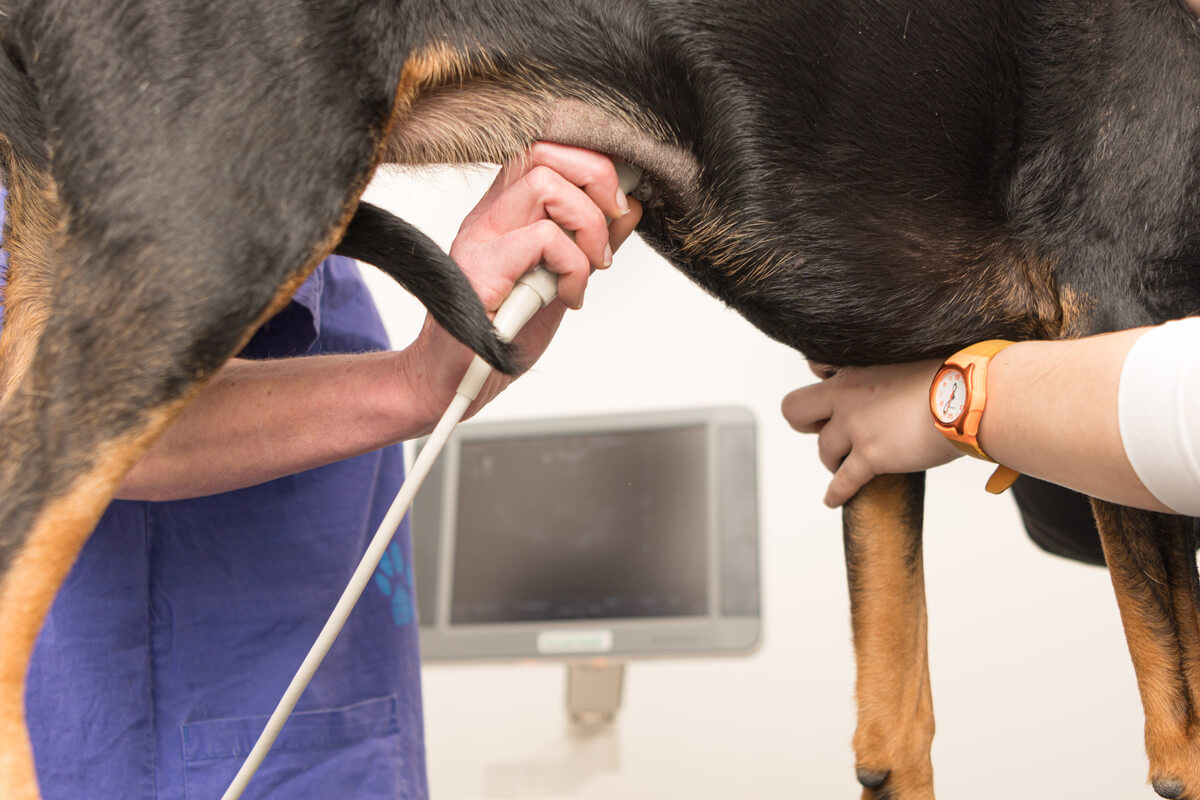My Dog Doesn't Have Testicles: Why?

The normal growth of the puppy includes the development of the reproductive system and this must be completed before the specimen reaches sexual maturity. Therefore, when problems occur in this process, you may find that your dog has no testicles or they don’t hang naturally.
What is this developmental anomaly? It’s important to know the natural steps of maturation in dogs so that you can identify possible problems. Here is all the information you need, so don’t miss out.
Why doesn’t my dog have testicles?
The testicles of newborn puppies aren’t visible, as they’re located inside the abdomen near the kidneys. It’s not until 6-8 weeks of life that they descend into the scrotum, the bag of skin that contains them in adult dogs.
If this descent doesn’t occur in this period, it doesn’t necessarily mean that the dog suffers from a disease, because the descent of the testicles can be delayed until 6 months of age. However, in the latter case, a veterinary follow-up will be necessary.
If the dog’s testicles don’t descend within the stipulated period, you may be dealing with a case of cryptorchidism. In the following sections, you’ll find the exact definition of this disorder and how to combat it.

What is cryptorchidism in dogs?
Cryptorchidism is a condition in which the dog’s testicles don’t descend into the scrotum during their normal period, or they do descend, but remain halfway. This condition can also occur because the dog doesn’t have testicles at all.
The disorder is quite common in dogs and is usually associated with pure breeds. The most commonly affected are toys or miniature breeds, such as the dwarf poodle, Pomeranian, and Pekingese. Some large dogs are also prone to it, such as the English bulldog and boxer.
Cryptorchidism is hereditary, so specimens that suffer from it shouldn’t be allowed to reproduce.
The testicles are usually retained in the inguinal canal, the cavity where they connect to the spermatic cord. If they’re there, they can be felt upon physical examination, but if the gonads haven’t descended, an ultrasound will be necessary.
Symptoms of cryptorchidism
Cryptorchidism usually doesn’t cause pain or specific symptoms, but some complications can occur. If complications do occur, some of the symptoms will be as follows:
- Acute abdominal pain: This is due to the spermatic cord has become entangled and is cutting off the irrigation in the area. The puppy will be listless (perhaps with fever) and will display a lot of pain when you touch his belly.
- A shrinking penis and enlarged breasts: There may be a problem in the development of one or both testicles due to abnormal secretion of female hormones.
This condition is associated with a high risk of testicular cancer, so it’s essential that you bring the animal to see a veterinarian. Testicular tumors are relatively common in adult dogs: Their incidence is between 0.7 and 4.6% of the tumors that domestic dogs usually suffer from.
What if my dog has only one testicle?
There is a form of cryptorchidism in which only one testicle descends, which is known as monorchidism. Although the cryptochordism causes infertility, monorchidism doesn’t (but experts still recommend against allowing the dog to breed).
The retained testicle has the potential to cause the same problems as in cryptorchidism, such as tumors or hormonal complications. Therefore, a veterinarian should assess the need for surgery to place it in the scrotal sac or remove it.
What if my dog’s testicles are too small?
You may find that your dog’s testicles descend within the normal time period, but are reduced in size. If this is the case with your puppy, there are 2 main causes:
- Testicular hypoplasia: This is a developmental disorder in which the testicles don’t reach their normal size.
- Testicular degeneration: The testicles that are initially normal in size can degenerate for a number of reasons. One cause is a high fever due to distemper or parvovirus, which increases the temperature of the scrotum and promotes testicular degeneration.
Usually, animals with smaller than normal testicles are infertile. However, sometimes infertility is reversible with the passage of time after the disease that causes it is cured.
What do I do if my dog has no testicles?
Since cryptorchidism and monorchidism are disorders that have the potential to cause serious problems (such as tumors), it’s imperative that you go to the vet. There, your dog will be tested and a plan will be put in place to correct the problem.
The most common solution is to have your dog neutered laparoscopically, as this is the only way to prevent testicular tumors. Another possible strategy is to inject hormones that induce the descent of the testicles, but they’re only administered when there are no physiological alterations in the dog. In addition, the latter is a treatment with little chance of success.
Finally, there are ways to help your dog so that his testicles descend in the stipulated period and without problems. The most effective are these 3:
- Keep your puppy from getting cold.
- Avoid times of excessive excitement and activity.
- You can massage the area of the inguinal canal from the time the dog is small.

However, the above methods don’t prevent disorders caused by genetics (such as cryptorchidism), but merely improve the conditions for the natural process to take place. As always, regular health checks and spaying or neutering are the best options to ensure your puppy’s well-being.
The normal growth of the puppy includes the development of the reproductive system and this must be completed before the specimen reaches sexual maturity. Therefore, when problems occur in this process, you may find that your dog has no testicles or they don’t hang naturally.
What is this developmental anomaly? It’s important to know the natural steps of maturation in dogs so that you can identify possible problems. Here is all the information you need, so don’t miss out.
Why doesn’t my dog have testicles?
The testicles of newborn puppies aren’t visible, as they’re located inside the abdomen near the kidneys. It’s not until 6-8 weeks of life that they descend into the scrotum, the bag of skin that contains them in adult dogs.
If this descent doesn’t occur in this period, it doesn’t necessarily mean that the dog suffers from a disease, because the descent of the testicles can be delayed until 6 months of age. However, in the latter case, a veterinary follow-up will be necessary.
If the dog’s testicles don’t descend within the stipulated period, you may be dealing with a case of cryptorchidism. In the following sections, you’ll find the exact definition of this disorder and how to combat it.

What is cryptorchidism in dogs?
Cryptorchidism is a condition in which the dog’s testicles don’t descend into the scrotum during their normal period, or they do descend, but remain halfway. This condition can also occur because the dog doesn’t have testicles at all.
The disorder is quite common in dogs and is usually associated with pure breeds. The most commonly affected are toys or miniature breeds, such as the dwarf poodle, Pomeranian, and Pekingese. Some large dogs are also prone to it, such as the English bulldog and boxer.
Cryptorchidism is hereditary, so specimens that suffer from it shouldn’t be allowed to reproduce.
The testicles are usually retained in the inguinal canal, the cavity where they connect to the spermatic cord. If they’re there, they can be felt upon physical examination, but if the gonads haven’t descended, an ultrasound will be necessary.
Symptoms of cryptorchidism
Cryptorchidism usually doesn’t cause pain or specific symptoms, but some complications can occur. If complications do occur, some of the symptoms will be as follows:
- Acute abdominal pain: This is due to the spermatic cord has become entangled and is cutting off the irrigation in the area. The puppy will be listless (perhaps with fever) and will display a lot of pain when you touch his belly.
- A shrinking penis and enlarged breasts: There may be a problem in the development of one or both testicles due to abnormal secretion of female hormones.
This condition is associated with a high risk of testicular cancer, so it’s essential that you bring the animal to see a veterinarian. Testicular tumors are relatively common in adult dogs: Their incidence is between 0.7 and 4.6% of the tumors that domestic dogs usually suffer from.
What if my dog has only one testicle?
There is a form of cryptorchidism in which only one testicle descends, which is known as monorchidism. Although the cryptochordism causes infertility, monorchidism doesn’t (but experts still recommend against allowing the dog to breed).
The retained testicle has the potential to cause the same problems as in cryptorchidism, such as tumors or hormonal complications. Therefore, a veterinarian should assess the need for surgery to place it in the scrotal sac or remove it.
What if my dog’s testicles are too small?
You may find that your dog’s testicles descend within the normal time period, but are reduced in size. If this is the case with your puppy, there are 2 main causes:
- Testicular hypoplasia: This is a developmental disorder in which the testicles don’t reach their normal size.
- Testicular degeneration: The testicles that are initially normal in size can degenerate for a number of reasons. One cause is a high fever due to distemper or parvovirus, which increases the temperature of the scrotum and promotes testicular degeneration.
Usually, animals with smaller than normal testicles are infertile. However, sometimes infertility is reversible with the passage of time after the disease that causes it is cured.
What do I do if my dog has no testicles?
Since cryptorchidism and monorchidism are disorders that have the potential to cause serious problems (such as tumors), it’s imperative that you go to the vet. There, your dog will be tested and a plan will be put in place to correct the problem.
The most common solution is to have your dog neutered laparoscopically, as this is the only way to prevent testicular tumors. Another possible strategy is to inject hormones that induce the descent of the testicles, but they’re only administered when there are no physiological alterations in the dog. In addition, the latter is a treatment with little chance of success.
Finally, there are ways to help your dog so that his testicles descend in the stipulated period and without problems. The most effective are these 3:
- Keep your puppy from getting cold.
- Avoid times of excessive excitement and activity.
- You can massage the area of the inguinal canal from the time the dog is small.

However, the above methods don’t prevent disorders caused by genetics (such as cryptorchidism), but merely improve the conditions for the natural process to take place. As always, regular health checks and spaying or neutering are the best options to ensure your puppy’s well-being.
All cited sources were thoroughly reviewed by our team to ensure their quality, reliability, currency, and validity. The bibliography of this article was considered reliable and of academic or scientific accuracy.
- Saldeña, E., Ferré, D., Quero, M., Hynes, V., Albarracín, L., & Gorla, N. (2014). Desde el criptorquidismo canino, un análisis de enfermedades genéticas en razas puras.
- Hernández, C. (2013). Criptorquidectomía laparoscópica en dos perros utilizando bisturí ultrasónico. Revista MVZ Córdoba, 18(2), 3577-3584.
This text is provided for informational purposes only and does not replace consultation with a professional. If in doubt, consult your specialist.








